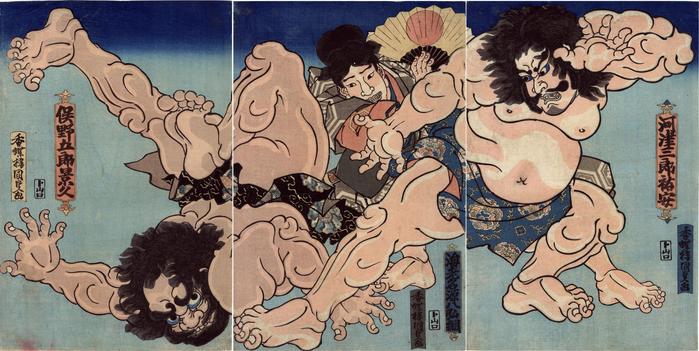Utagawa Kunisada (歌川国貞) / Toyokuni III (三代豊国) (artist 1786 – 01/12/1865)
Kawazu Saburō Sukeyasu (河津三郎祐安) wrestling Matano Gorō Kagehisa (股野五郎景久) with Ebina Genpachi Hirotsuna (海老名源八弘綱) as referee
ca 1838 – 1840
10 in x 14.75 in (Overall dimensions) Japanese color woodblock print
Signed: Kōchōrō Kunisada ga
香蝶楼国貞画
Publisher: Yamaguchiya Tōbei
(Marks 591 - seal not listed)
Museum of Fine Arts, Boston
National Diet Library
Edo-Tokyo Museum - center and right panels only
Victoria and Albert Museum
National Museum of Asian Art Sebastian Izzard wrote in his Kunisada's World:
"Kunisada produced several versions of this match, the earliest of which is dated to about 1812. In this later version Kunisada employs the strong colors of the Tempo era and the Chinese-style clothing patterns that had become fashionable int he late 1820s. The heavy outlines and caricatured faces are typical of the bold drawing in the style of Katsukawa Shun'ei that was used by Kunisada to portray this type of scene.
This celebrated match, refereed by Ebina Gempachi, took place during a hunting expedition organized by the general Minamoto no Yoritomo in 1176 near Mt. Akazawa. Matano Gorō Kagehisa, who had some professional experience as a wrestler, challenged members of the party and defeated them one by one. He then challenged Kawazu Saburō Sukeyasu, who, after first refusing, pushed Matano back and threw him to the ground. Matano claimed that he had tripped and a rematch was held. Kawazu twisted his foot behind Matano and toppled him, a trick throw still known as the kawazu [the kawazu-gake 河津掛] in his honor. Kawazu was later found murdered and his two sons, Jūrō and Gorō, gained renown when they sought revenge, an act well known as the vendetta of the Soga brothers..."
****
Lawrence Bickford in his Sumo and the Woodblock Print Masters dates this triptych to 1842. No other source gives such a late date. Not only that Bickford implies that Kunisada was trying to get around the restrictions which had been put on elaborately printed woodblock images. His argument is that that explains why there are no censor's seals on any of these panels.
****
In an early kabuki production of the encounter on Mt. Akazawa the poet Hezutsu Tōsaku wrote of "The kabuki actor Ōtani Hiroji [I] 大谷広治 (1696–1747), three generations before the current bearer of that name, had a very dark complexion and was nick-named “black Jitchō” (黒十町). He excelled in the delivery of his lines. Although he could not read a word, he related historical events and used ancient phrases without sounding as if he were repeating what others had read out for him. When he spoke of the wrestling match of Matano [Kagehisa] 股野景久 (?–1183), he raised his voice with the lines, “And lo! He was thrown three inches deep into the black earth of Mt. Akazawa 赤沢,” and then, in a lower and softer voice, he continued, “Ah! He felt as if he had lived his life in vain!”56 Listeners were deeply moved and shouted their approval." Translated by Gerald Groemer.
****
Illustrated
1) in color in 'On the Composition of Utagawa Kuniyoshi's Wide Screen Works' by Nakayama Sota in Journal of East Asian cultural interaction studies, 2014, #5, p. 95. [We believe that the term 'Wide Screen' is tantamount to 'triptych'.]
2) in black and white in Ukiyo-e Masterpieces in European Collection 5: Victoria and Albert Museum II, Kodansha, 1989, page 162, #8.
3) in a large, two page spread, reproduction in Japanese Prints by Catherine David, 2010, Éditions Place des Victoires, pp. 384-385.
4) in a two page color reproduction in Kunisada's World by Sebastian Izzard, Japan Society, Inc., 1993, pages 160-161.
5) in a color reproduction in Sumo and the Woodblock Print Masters by Lawrence Bickford, Kodansha International, 1994, pages 42-43, #44.
6) in color in Ukiyo-e by Gian Carlo Calza, Phaidon, 2005, page 156, #11.69.
sumō (相撲) (genre)
Yamaguchiya Tōbei (山口屋藤兵衛) (publisher)
Soga brothers (曾我兄弟) (genre)
